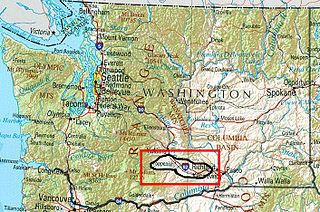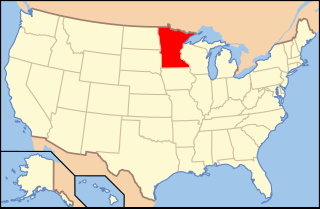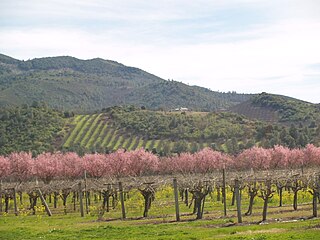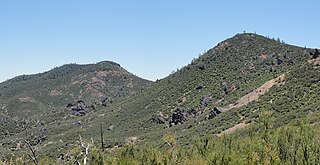
Carmel Valley is an American Viticultural Area (AVA) located in Monterey County, California, southeast of Carmel-by-the-Sea and it is one of the ten AVAs in the county. Approximately 100 miles (161 km) south of San Francisco, the AVA was recognized by the Bureau of Alcohol, Tobacco and Firearms (ATF), Treasury on January 13, 1983 after reviewing the petition submitted by Mr. David Armanasco, General Manager of Durney Vineyard, located in Carmel, to propose a viticultural area named “Carmel Valley.”

Washington wine is a wine produced from grape varieties grown in the U.S. state of Washington. Washington ranks second in the United States in the production of wine. By 2017, the state had over 55,000 acres (220 km2) of vineyards, a harvest of 229,000 short tons (208,000 t) of grapes, and exports going to over 40 countries around the world from the 940+ wineries located in the state. While there are some viticultural activities in the cooler, wetter western half of the state, the majority (99.9%) of wine grape production takes place in the shrub-steppe eastern half. The rain shadow of the Cascade Range leaves the Columbia River Basin with around 8 inches (200 mm) of annual rain fall, making irrigation and water rights of paramount interest to the Washington wine industry. Viticulture in the state is also influenced by long sunlight hours and consistent temperatures.

Columbia Gorge is an American Viticultural Area (AVA) which includes land surrounding the Columbia River Gorge, straddling the border between Oregon and Washington. The AVA was established by the Alcohol and Tobacco Tax and Trade Bureau {TTB), Treasury on July 9, 2004 after reviewing the petition submitted by Mark Wharry, on behalf of the Columbia River Gorge Wine Growers Association, proposing the viticultural area named "Columbia Gorge." The 280 square miles AVA is located about 60 miles (97 km) east of Portland, Oregon, straddles the Columbia River for 15 miles (24 km), and extends into south-central Washington and north-central Oregon. The area surrounds Hood River, Oregon, and White Salmon, Washington, and is generally bordered by B Z Corner, Washington, on the north; Lyle, Washington, on the east; Parkdale, Oregon, on the south; and Vinzenz Lausmann State Park, Oregon, on the west. The area is just west of the established Columbia Valley viticultural area and shares a border with it. Due to the significant gradations of climate and geography found in the gorge, this AVA exhibits a wide range of terroir in a relatively small region; it is marketed as a "world of wine in 40 miles".

Columbia Valley is an American Viticultural Area (AVA) which lies within the Columbia River Plateau, through much of central and southern Washington state, with a section crossing the state boundary into northern Oregon south of the Columbia River. The viticultural area includes the drainage basin of the Columbia River and its tributaries through much of Washington. It was established by the Bureau of Alcohol, Tobacco and Firearms (ATF), Treasury on December 13, 1984 after evaluating the petition filed by Drs, Walter Clore and Wade Wolfe of Prosser, Washington on behalf of Washington’s oldest and largest winery, Chateau Ste. Michelle, and by William Blosser of the Sokol Blosser Winery, Dundee, Oregon. Allen Shoup, president of Chateau Ste. Michelle, understood the importance of obtaining appellation status to grow the reputation of the Northwest viticulture industry.

Yakima Valley is the first American Viticultural Area (AVA) established within Washington state, gaining the recognition on May 4, 1983. Within the vast Columbia Valley AVA, Yakima Valley appellation cultivates more than 53,000 acres (21,448 ha) giving the region the largest concentration of wineries and vineyards in the state. The most widely planted varietals in the area are Chardonnay, Riesling, Merlot, Cabernet Sauvignon, Pinot gris, and Syrah. Nearly 40% of Washington's annual wine production is made from Yakima Valley grapes. In addition to grapes, the Yakima Valley is also home to several fruit orchards growing apples, cherries, nectarines, peaches, pears and plums. Around the town of Zillah, there is the Zillah Fruit Loop driving tour through the area's orchards and vineyards. The area is also home to nearly 80% of the US hop production.

Red Mountain is an American Viticultural Area (AVA) that encompasses the local region surrounding Red Mountain in Benton County, Washington. The viticultural area was formally recognized on June 11, 2001 by the Bureau of Alcohol, Tobacco and Firearms (ATF), Treasury after reviewing the petition submitted by Lorne Jacobson of Hedges Cellars to establish an area known as "Red Mountain." It lies entirely within the Yakima Valley and vast Columbia Valley appellations and is the smallest AVA in the state at only 4,040 acres (6.31 sq mi) in area and lies between Benton City and the City of West Richland. The area has more than 2,225 acres (900 ha) under cultivation of primarily red varietals including Cabernet Sauvignon, Merlot, Sangiovese, Cabernet Franc and Syrah. The reputation of the area's wines has brought Red Mountain worldwide attention and acclaim for producing some of the most desired Washington State vintage wines.

Walla Walla Valley is an American Viticultural Area (AVA) located within Washington state and extending partly into the northeastern corner of Oregon. The wine region is entirely included within the larger Columbia Valley AVA. In addition to grapes, the area produces sweet onions, wheat and strawberries After the Yakima Valley AVA, the Walla Walla AVA has the second highest concentration of vineyards and wineries in Washington State. Walla Walla hosts about 140 wineries. The area was recognized on March 7, 1984 by the Bureau of Alcohol, Tobacco and Firearms (ATF), Treasury after reviewing the petition submitted by Mr. Richard L Small, President of the Walla Walla Valley Winegrowers Association, for the establishment of a viticultural area in southeast Washington and northeast Oregon, east of Lake Wallula, to be known as "Walls Walls Valley." At the time, Walla Walla Valley viticultural area was approximately 178,560 acres (279 sq mi) with two bonded wineries and about 60 acres (24 ha) from several vineyards.

Rattlesnake Hills is an American Viticultural Area (AVA) located in Yakima County, Washington surrounding the Rattlesnake Hills. The appellation is the state's 9th AVA established on March 20, 2006 by the Alcohol and Tobacco Tax and Trade Bureau {TTB), Treasury after reviewing the petition submitted by Mr. Gail Puryear, Bonair Winery owner, along with 10 other vineyard and winery owners in the region proposing the "Rattlesnake Hills" viticultural area. The 68,500 acres (107 sq mi) Rattlesnake Hills AVA boundaries are within the Yakima Valley AVA as both are encompassed by the vast Columbia Valley AVA. Rattlesnake Hills borders the northern boundary of Yakima Valley including land between the north bank of the Sunnyside Canal and the entire southern boundary slopes are between Outlook and the Wapato Dam. The western boundary meanders on an east-west chain of hills north of I-82 passing through the cities of Parker, Donald, Buena and Zillah while just east of the Yakima River. Rattlesnake Hills rises to the highest point in the Yakima Valley with elevations ranging from 850 to 3,085 feet (259–940 m).

Red Mountain is located in the southeast corner of Washington state near the Tri-Cities between Rattlesnake Mountain and Candy Mountain. This region is situated among the Columbia, Snake and Yakima Rivers. The mountain covers an area of approximately 4,040 acres (6.31 sq mi). Its name is derived from the red-wine springtime bloom of the drooping brome or "cheatgrass" on its slopes.

New York wine refers to wine made from grapes grown in the U.S. state of New York. New York ranks third in grape production by volume after California and Washington. 83% of New York's grape area is Vitis labrusca varieties. The rest is split almost equally between Vitis vinifera and French hybrids.

Snake River Valley is Idaho’s first American Viticultural Area (AVA) that encompasses an area in southwestern Idaho and two counties in eastern Oregon. The area was established on April 9, 2007 by the Alcohol and Tobacco Tax and Trade Bureau (TTB), Treasury after reviewing the petition submitted by Idahoan vintners of the Snake River Valley, the Idaho Grape Growers and Wine Producers Commission, and the Idaho Department of Commerce and Labor, collectively acting as “petitioner” to establish the 8,263 square miles viticultural area named "Snake River Valley." For wines to bear the "Snake River Valley" label, at least 85% of the grapes used for production must be grown in the designated area, which includes the southwestern Idaho counties of Ada, Adams, Boise, Canyon, Elmore, Gem, Gooding, Jerome, Owyhee, Payette, Twin Falls, and Washington, and the Eastern Oregon counties of Malheur and Baker. The appellation, when established, was resident to 15 wineries and 46 vineyards with 1,800 acres (728 ha) under vine.

Sonoma County wine is wine made in Sonoma County, California, in the United States.

Santa Cruz Mountains AVA is an American Viticultural Area (AVA) centered on the Santa Cruz Mountains. Its territory spans three California counties, Santa Clara, Santa Cruz and San Mateo and was established January 4, 1982 by the Bureau of Alcohol, Tobacco and Firearms (ATF), Treasury. Santa Cruz Mountains AVA was among the first AVA to be defined by its mountainous topography. Based on elevation, it largely follows the fog line along the coast, extending down to 800 feet (240 m) on the eastern slope toward San Francisco Bay, 400 feet (120 m) on the western slope to the Pacific Ocean and extending along the ridge crest line at 3,000 feet (910 m) elevation plus.

Minnesota wine refers to wine made from grapes grown in the U.S. state of Minnesota. Minnesota is part of the largest American Viticultural Area (AVA), the Upper Mississippi River Valley AVA, which includes southwest Wisconsin, southeast Minnesota, northeast Iowa, and northwest Illinois. The state also has a smaller designated American Viticultural Areas, the Alexandria Lakes AVA. Minnesota is a very cold climate for viticulture and many grape varieties require protection from the winter weather by being buried under soil for the season. Minnesota is home to extensive research on cold-hardy French hybrid and other grape varieties.

El Dorado is an American Viticultural Area (AVA) located in El Dorado County, California, east of the state’s capital, Sacramento and centered around the county seat of Placerville. It was established on November 14, 1983 by the Bureau of Alcohol, Tobacco, Firearms and Explosives (ATF), Treasury after approving the submitted petition from the El Dorado Wine Grape Growers Association of Camino, California applying to establish a viticultural area named "El Dorado.” The area includes parts of El Dorado County on the north border by the Middle Fork American River and on the south by the South Fork of the Cosumnes River. El Dorado viticultural area lies within the vast 4,062 square miles Sierra Foothills viticultural area, one of the largest appellations in California, which extends about 170 miles (274 km) through portions of Yuba, Nevada, Placer, El Dorado, Amador, Calaveras, Tuolumne and Mariposa Counties. The El Dorado viticultural area encompasses 1,093,120 acres (1,708 sq mi) which entirely includes Fair Play and a small portion of northeastern California Shenandoah Valley AVAs.

Lake County wine is an appellation that designates wine made from grapes grown mostly in Lake County, California. The region is located north of Napa County and east of Mendocino County. Although each region within Lake County has unique viticultural attributes, many are influenced by Clear Lake, the largest inland body of water in California.

Grand Valley is an American Viticultural Area (AVA) within Mesa County, Colorado located in a high-altitude river valley surrounding the county seat of Grand Junction and stretching 24 miles (39 km) east-west between the municipalities of Palisade and Fruita. It lies approximately 200 miles (320 km) west-southwest of Denver along Interstate 70. The river valley encompasses 75,990 acres (118.73 sq mi), with an average elevation between 4,000 and 5,000 feet (1,200–1,500 m) above sea level and is defined by an irrigated agricultural area served by canals in the Grand Valley of the Colorado River. Grand Valley AVA was established by the Bureau of Alcohol, Tobacco and Firearms (ATF) on December 26, 1991, upon the petition submitted by Mr. James Seewald of Vintage Colorado Cellars Winery, and the first viticultural area registered in the Centennial State. In 2001, the smaller West Elks AVA, located southeast of Grand Valley, became the state's second federally-designated AVA.
Squaw Valley-Miramonte is an American Viticultural Area (AVA) and a unique grape-growing region in Fresno County, California surrounding the towns of Squaw Valley and Miramonte approximately 40 miles (64 km) east of the city of Fresno. The AVA was established on August 7, 2015 by the U.S. Department of Treasury’s Alcohol and Tobacco Tax and Trade Bureau (TTB). It is largely a rural region located entirely within the foothills of the Sierra Nevada mountains and does not overlap any established AVAs. To the northwest, west, and south is the San Joaquin Valley while the Sequoia National Forest is adjacent to its northern and eastern boundaries. The scenic highway U.S. 180 bisects the region eastward from the Valley to the Big Trees in Kings Canyon and Sequoia National Parks. The AVA stretches over 44,690 acres (70 sq mi) with five commercially-producing vineyards cultivating about 7.5 acres (3.04 ha) and three bonded wineries. The USDA plant hardiness zone for the AVA is 9b.

Monterey County wine is a appellation that designates wine made from grapes grown in Monterey County, California which lies entirely within the expansive multi-county Central Coast viticultural area. County names in the United States automatically qualify as legal appellations of origin for wine produced from grapes grown in that county and do not require registration with the Alcohol and Tobacco Tax and Trade Bureau (TTB). TTB was created in January 2003, when the Bureau of Alcohol, Tobacco and Firearms, or ATF, was extensively reorganized under the provisions of the Homeland Security Act of 2002.

Gabilan Mountains is an American Viticultural Area (AVA) located in the mountainous region on the border in Monterey and San Benito Counties in California. It is the tenth and newest AVA established in Monterey County by the Alcohol and Tobacco Tax and Trade Bureau (TTB) on September 14, 2022, becoming the state's 147th official AVA after the TTB reviewed the petition from Parker Allen of Coastview Vineyards, proposing to establish the "Gabilan Mountains" viticultural area. Gabilan Mountains encompasses about 98,000 acres (153 sq mi) including the established Mt. Harlan and Chalone AVAs, and resident to 4 wineries and 6 commercial vineyards cultivating approximately 436 acres (176 ha). The average elevation within the region is 2,370 feet (722 m) placing it above the heavy fog and marine layer. As a result, Gabilan Mountains AVA has a cool air climate without the humidity from the fog and low-lying clouds.




















